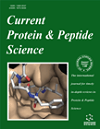- Home
- A-Z Publications
- Current Protein and Peptide Science
- Previous Issues
- Volume 19, Issue 1, 2018
Current Protein and Peptide Science - Volume 19, Issue 1, 2018
Volume 19, Issue 1, 2018
-
-
Protein Engineering Approaches in the Post-Genomic Era
More LessProteins are one of the most multifaceted macromolecules in living systems. Proteins have evolved to function under physiological conditions and, therefore, are not usually tolerant of harsh experimental and environmental conditions. The growing use of proteins in industrial processes as a greener alternative to chemical catalysts often demands constant innovation to improve their performance. Protein engineering aims to Read More
-
-
-
Re-engineering of Bacterial Luciferase; For New Aspects of Bioluminescence
More LessAuthors: Da-Som Kim, Jeong-Ran Choi, Jeong-Ae Ko and Kangmin KimBacterial luminescence is the end-product of biochemical reactions catalyzed by the luciferase enzyme. Nowadays, this fascinating phenomenon has been widely used as reporter and/or sensors to detect a variety of biological and environmental processes. The enhancement or diversification of the luciferase activities will increase the versatility of bacterial luminescence. Here, to establish the strategy for luciferase engineerin Read More
-
-
-
Chondroitin Sulfate (CS) Lyases: Structure, Function and Application in Therapeutics
More LessAuthors: Aruna Rani, Seema Patel and Arun GoyalGlycosaminoglycans (GAGs) such as chondroitin sulfate (CS) are the chief natural polysaccharides which reside in biological tissues mainly in extracellular matrix. These CS along with adhesion molecules and growth factors are involved in central nervous system (CNS) development, cell progression and pathogenesis. The chondroitin lyases are the enzyme that degrade and alter the CS chains and hence modify various si Read More
-
-
-
Insights into Structure and Reaction Mechanism of β-Mannanases
More LessAuthors: Kedar Sharma, Arun Dhillon and Arun Goyalβ-mannanases have been shown to play an important role in various biological processes such as the cell wall component degradation, defence signalling in plants, the mobilization of storage reserves and in various industrial processes. To date, glycoside hydrolases (GHs) have been divided into 135 families and 14 clans from A to N based upon their sequence, overall structural fold and function. β -mannanases belong glycos Read More
-
-
-
Structural Considerations on the Use of Endo-Xylanases for the Production of prebiotic Xylooligosaccharides from Biomass
More LessAuthors: Javier A. Linares-Pasten, Anna Aronsson and Eva Nordberg KarlssonXylooligosaccharides (XOS) have gained increased interest as prebiotics during the last years. XOS and arabinoxylooligosaccharides (AXOS) can be produced from major fractions of biomass including agricultural by-products and other low cost raw materials. Endo-xylanases are key enzymes for the production of (A)XOS from xylan. As the xylan structure is broadly diverse due to different substitutions, diverse endo-xylanases hav Read More
-
-
-
Metabolic Engineering for Probiotics and their Genome-Wide Expression Profiling
More LessAuthors: Ruby Yadav, Puneet K. Singh and Pratyoosh ShuklaProbiotic supplements in food industry have attracted a lot of attention and shown a remarkable growth in this field. Metabolic engineering (ME) approaches enable understanding their mechanism of action and increases possibility of designing probiotic strains with desired functions. Probiotic microorganisms generally referred as industrially important lactic acid bacteria (LAB) which are involved in fermenting dairy products, f Read More
-
-
-
Microbial P450 Enzymes in Bioremediation and Drug Discovery: Emerging Potentials and Challenges
More LessAuthors: Sukanta S. Bhattacharya and Jagjit S. YadavCytochrome P450 enzymes are a structurally conserved but functionally diverse group of heme-containing mixed function oxidases found across both prokaryotic and eukaryotic forms of the microbial world. Microbial P450s are known to perform diverse functions ranging from the synthesis of cell wall components to xenobiotic/drug metabolism to biodegradation of environmental chemicals. Conventionally, many microbial s Read More
-
-
-
Recombinant Approaches for Microbial Xylanases: Recent Advances and Perspectives
More LessAuthors: Moumita Basu, Vishal Kumar and Pratyoosh ShuklaXylanases are crucial enzymes to hydrolyse the xylan of plant hemicellulose in order to complete the carbon cycle. Xylanases have been used widely in a variety of industries ranging from food and feed industry to pulp and paper industry. Most of the industrial processes which using xylanase requires a thermostable and alkali stable enzyme. Therefore it is desired to produce high thermostable and alkali stable xylana Read More
-
-
-
Stimulation of Laccase Biocatalysis in Ionic Liquids: A Review on Recent Progress
More LessAuthors: Hao Liu, Xing Wu, Jianliang Sun and Shicheng ChenIt has been well known that laccases can directly or indirectly catalyze oxidation of a broad species of phenols, amines and many other electron donor substrates. However, laccases as biocatalyst in “green” ionic liquids (ILs) media instead of conventional solvents are less known and regarded as an innovative research direction. The presence of ILs can either inhibit or stimulate laccase activity, strongly depending on water-mis Read More
-
-
-
Engineering Virus-like Particles for Antigen and Drug Delivery
More LessAuthors: Brett D. Hill, Andrew Zak, Eshita Khera and Fei WenVirus-like particles (VLPs) are nanoscale biological structures consisting of viral proteins assembled in a morphology that mimic the native virion but do not contain the viral genetic material. The possibility of chemically and genetically modifying the proteins contained within VLPs makes them an attractive system for numerous applications. As viruses are potent immune activators as well as natural delivery vehicles of genetic mat Read More
-
Volumes & issues
-
Volume 26 (2025)
-
Volume 25 (2024)
-
Volume 24 (2023)
-
Volume 23 (2022)
-
Volume 22 (2021)
-
Volume 21 (2020)
-
Volume 20 (2019)
-
Volume 19 (2018)
-
Volume 18 (2017)
-
Volume 17 (2016)
-
Volume 16 (2015)
-
Volume 15 (2014)
-
Volume 14 (2013)
-
Volume 13 (2012)
-
Volume 12 (2011)
-
Volume 11 (2010)
-
Volume 10 (2009)
-
Volume 9 (2008)
-
Volume 8 (2007)
-
Volume 7 (2006)
-
Volume 6 (2005)
-
Volume 5 (2004)
-
Volume 4 (2003)
-
Volume 3 (2002)
-
Volume 2 (2001)
-
Volume 1 (2000)
Most Read This Month
Article
content/journals/cpps
Journal
10
5
false
en


